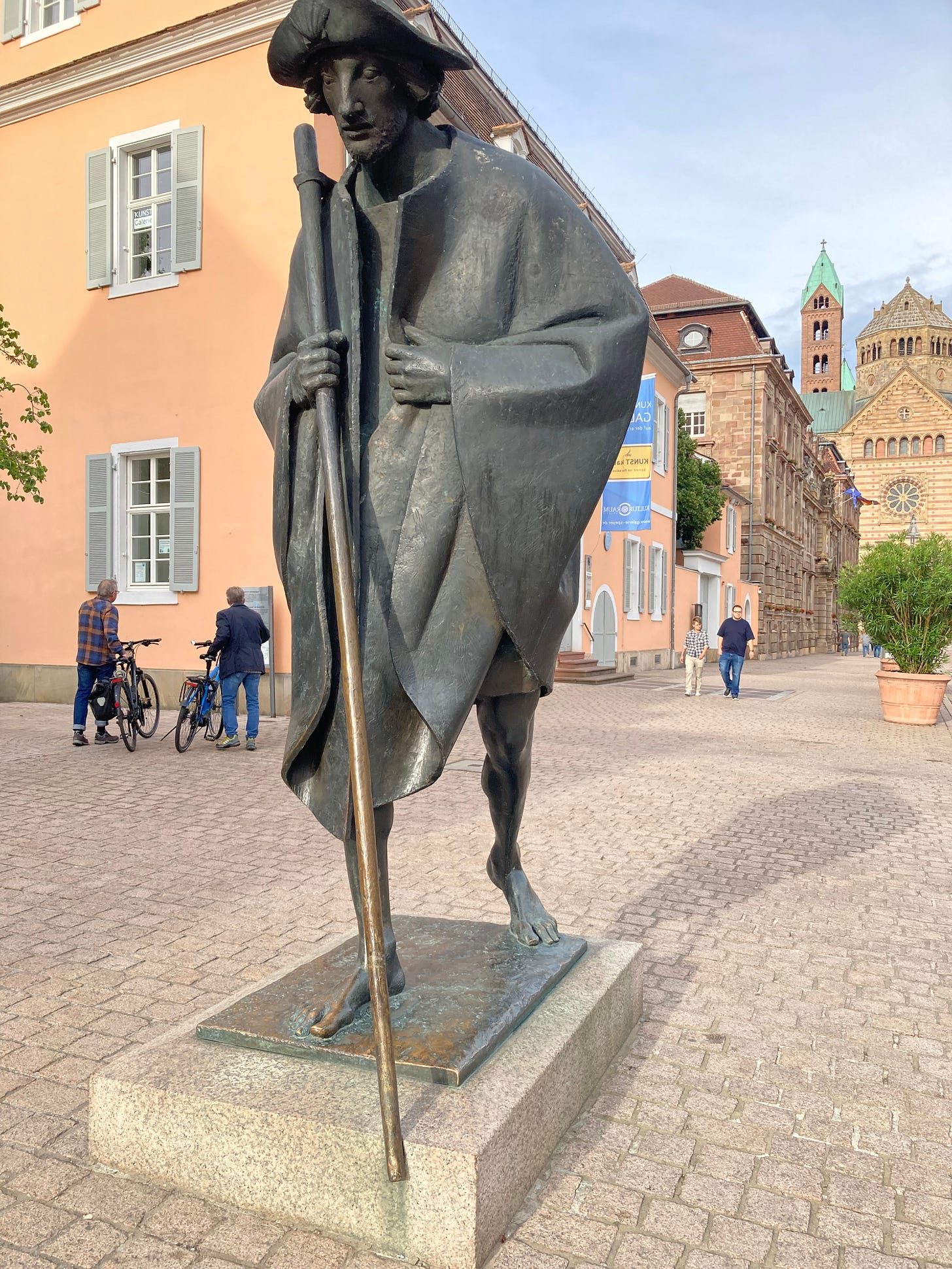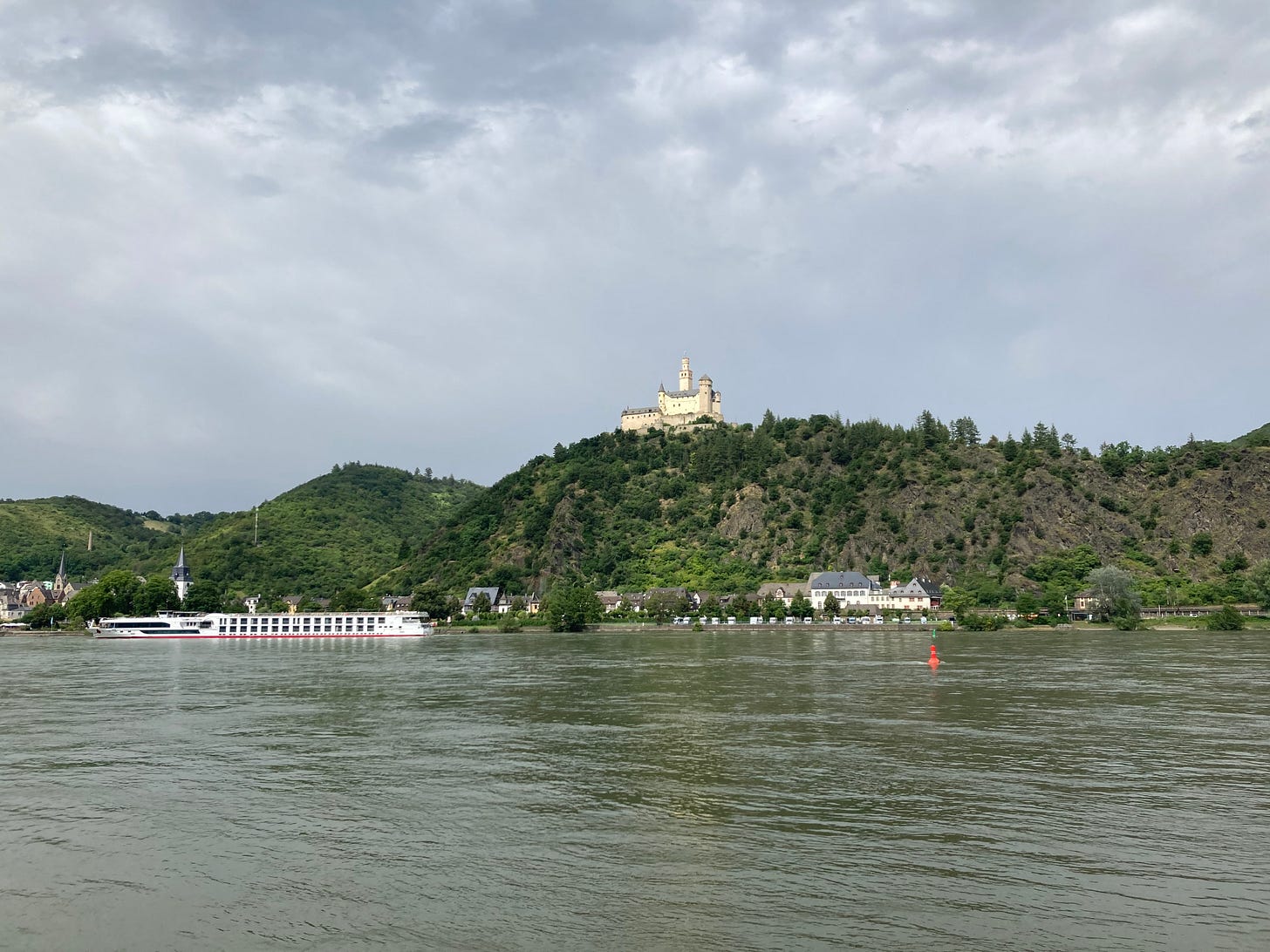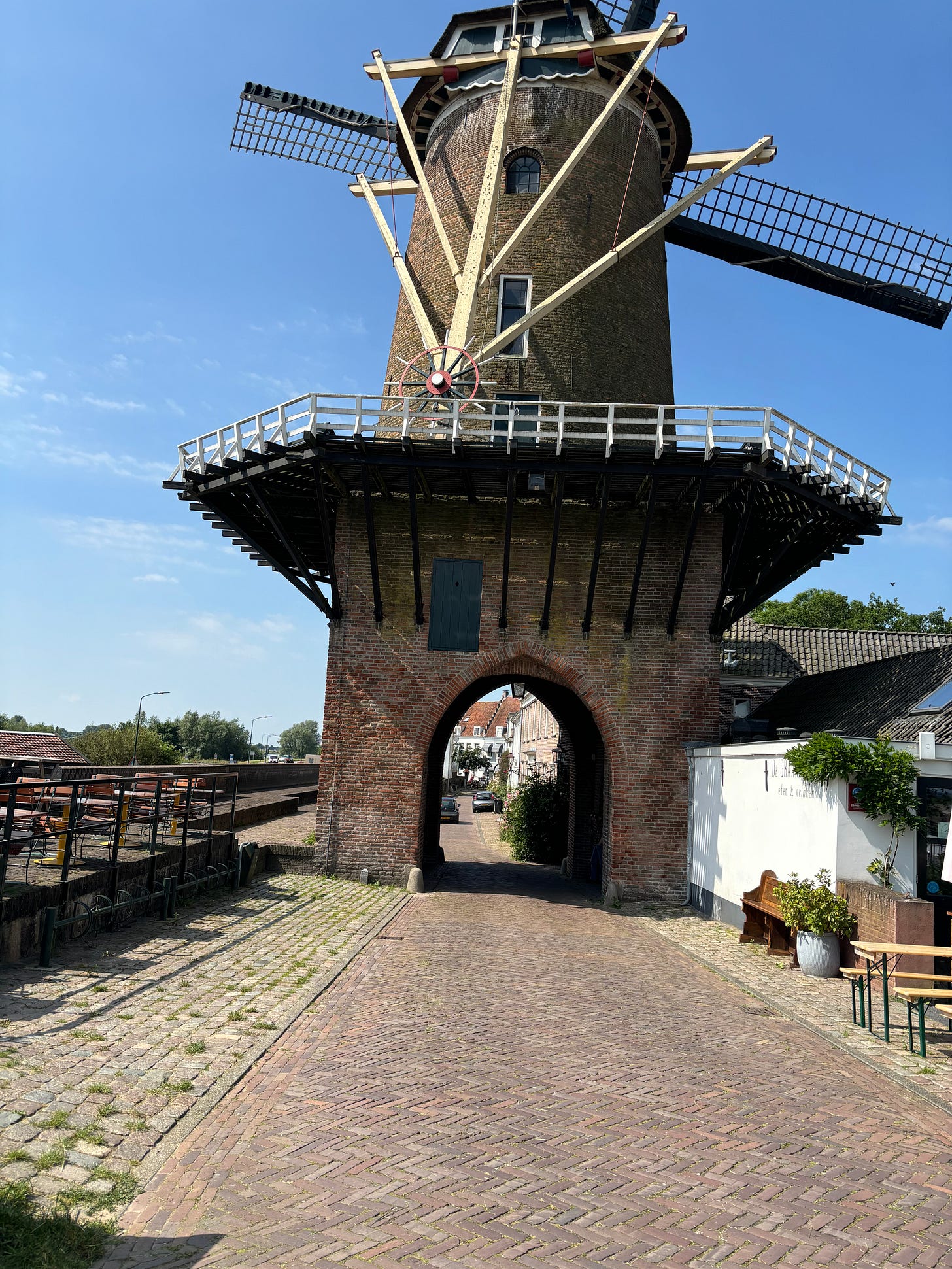Rolling on the Rhine River (part three)
And finally, to the North Sea
Catholicism and the Craft of Bicycle Maintenance
I crossed back over into Germany and rode into Speyer, a medieval city dominated by its millennium-old cathedral. The basilica’s bells chime each quarter hour, and they helped nudge me into a contemplative mood.
As I wandered through the town looking for dinner, I came face-to-face with a statue of a traveler and a German-language plaque that made mention of Jakob Spilger and the Camino de Santiago. I wondered about the man and what the ancient medieval town had to do with that famous Spanish pilgrimage.
My interest in the Camino was not new. I’d toured on my bike enough to know that long hours in the saddle can lead to a type of monkish experience, and I sometimes wondered if my ride wasn't my version of Europe's most famous pilgrimage. I’d read about it many times and recently watched the fine little indie movie, The Way.
Although “The Camino” was a pilgrimage originally intended for the Catholic faithful, its appeal has spread far beyond Roman Catholics. A recent survey showed that just 28% of those who walk that trail do so as a pilgrimage.
For this non-pilgrim, the solitude of riding hundreds of miles along the Rhine, the enforced unplugging from technology and media, and the pastoral landscape shared some kinship with that increasingly crowded trail.
It turns out Jakob Spilger doesn’t exist, but Jakobs Pilger is the German phrase for one who walks the Camino. The statue was a gift to the city from a Catholic Bishop to honor the two-thousand-year anniversary of the city's founding along with a nod to those that make that pilgrimage.
North of Speyer, big cities dominate the German Rhine. Eurovelo 15 runs through Mannheim, Mainz, Koblenz, Koln, Dusseldorf, and Duisburg—all industrial or military cities.
The cities have all well-maintained, well-marked cycling paths, but they are not just for leisure bike tourists. They also make up a good portion of commuting traffic.
And with all those cyclists rushing to work on those paths comes real traffic. Cycling laws are a real concern and tickets are common for cyclists. As a recreational rider, it was quite unsettling to deal with real cycling traffic issues.
In cities where cycling is an important part of the transportation mix, understanding the specific signage and rules that apply to cycling is vital to riding safely. Drivers and other cyclists need to be able to predict your actions, and that is often driven by cycling rules that feel foreign to Americans.
One example is the European "priority from the right" principle, meaning that whoever is on your right gets to go first, whether it's a car or a bike. More than once, I stopped at an intersection to get my bearings only to be berated in German by a truck driver that had to pause in the street and wait for me.
I didn’t feel comfortable riding in those settings, and the monkish pilgrim in me looked for ways to get off my bike whenever I got to a big city. For the most part, I tended to look for rooms a couple of miles north of the city center away from the hustle and bustle. Riding from the South, choosing a stop North of the city meant that my morning start would be into the quiet country rather than the city. And rooms outside the city center were usually cleaner, cheaper, and quieter.
I’d ride to the hotel for a shower, leave everything but a lock in my room, and ride back to the Aldstadt (or old town) to explore and have dinner. A ride back to the hotel afterward and in the morning, I’d start my day riding in vineyards or pastures. Zoning laws in Germany are such that there is less sprawl and the demarcation between city and country is more distinct.
The river becomes quite industrial this far north with shipping boats dominating the waters. They make an interesting contrast with the medieval castles that dot the overlooking hills.
Although some of the freight is containerized like massive oceanic ships, the scale is much smaller. Most of these vessels are family-owned with the owners/operators living on the boat and the family car parked behind the ship bridge.
A memorable small town among the big metropolises is Bacharach, one of the best-preserved medieval towns in the country.
Xanten is the last major town on the trail in Germany. When I stopped on its main square, I was treated to competing sequential concerts from three different church bell towers over the forty-five minutes it took me to eat my brunch. Soon, I was in Holland.
Riding off into the Sunset
One of the pleasures of cycling is taking in the unfiltered air of a place. A climate-controlled car rolling through a landscape at eighty kilometers cannot connect to the land in the same way as a ride. The earthy smell of the Dutch countryside is grounding, with many wildflowers adding a sweetness on top of the manure that farmers spread across the crop fields.
Photographers talk of a "golden hour"-- that brief time before dusk when the sunlight takes on a golden hue that brings life to the landscape. Filmmakers are known to rush like madmen or wait all day just to capture a shot in that perfect forty-five minutes or so. In the Dutch countryside, that light goes on for hour upon hour. Riding through it in the afternoon felt magical. Days later, when I was off my bike and enjoying a few days in Amsterdam, I would wait in line and take my turn to stand in front of those mythic Van Gogh landscapes and know exactly where those colors came from.
On the final morning of the trek, I rode out of the town of Schoonhoven and for one last time headed toward the North Sea. I had forty miles left to ride. The sheep, cows, and occasional horses I rode past did not share my delight with the many varieties of windmills I encountered. All roads led to Rotterdam.
Rotterdam has much to offer, but the end of the ride was near and none of those offerings interested me. I stopped at the train station and put my panniers in a locker, knowing that for the first time in a month, I would return to the same place later that day. The bike felt lighter than ever. The sea was ahead.
The end of Eurovelo 15 is at Hoek Van Holland, a small beach town popular with locals. I spent the last few kilometers of my epic 850-mile ride passing families with beach toys and blankets strapped to their bikes. It reminded me that as much as anything, I was grateful to encounter the everyday for the people along the way.
There was no marker or ceremony with a medal or t-shirt at the end of the trail. Just a local beach resort with tourists laying in the summer sun or having a drink at the beachfront stalls. I pushed my bike across the sugar-white sand and piled my riding shoes and socks in a little mound. The water was cold, but it felt fresh and clean. I washed my feet and face in it and looked back south. I handed my phone to a passing tourist and asked him to take a picture of me with my wheels in the North Sea. I tried to explain what the moment meant, but he spoke no English and I spoke no Dutch.
I could not tell him that this was the end of a pilgrimage, that I had accomplished something that seemed like a fantasy for years. That I had somehow changed myself over the last month. I could not explain to him that this little stretch of beach that locals ride the metro train to on a Tuesday afternoon was somehow a sacred place for me now. I could only thank him and smile.
Song of the Week
I know, I know—I posted a Creedence Clearwater Revival song for the first part of this story. But this past Friday, John Fogerty released an album of new recordings of his CCR classics. Fogerty, one of the songwriters that defined my childhood, was cheated out of the rights to his awe-inspiring catalog over fifty years ago. In a field that is known for them, this was one of the great injustices of Rock and Roll.
Two years ago, he regained those rights. And you can hear the joy in his voice as he revives them again after these many decades. So yes, I’m posting another Fogerty song, but how can you complain about that.
And this is really a doozy. John has got the kind of voice that only gets better with age.





All this talk of pilgrims and not one mention of the Mayflower or turkey. Rewrite.
Absolutely beautiful. That you completed this physical and spiritual journey and feel changed makes me tear up for you. I have a number of friends who have walked the Camino. You probably know that put a scallop shell on their backpack. Perhaps the joyful picture of you at the end at the river with your bike should be put in a small frame and travel with you now.